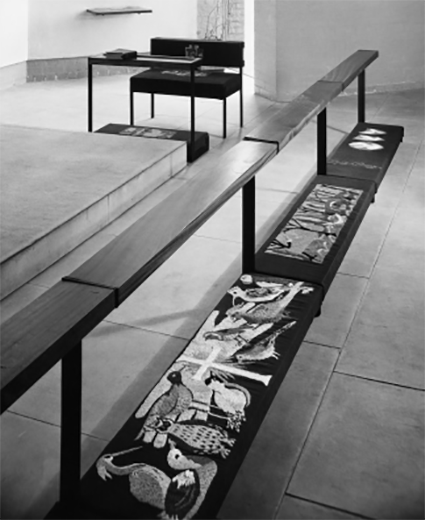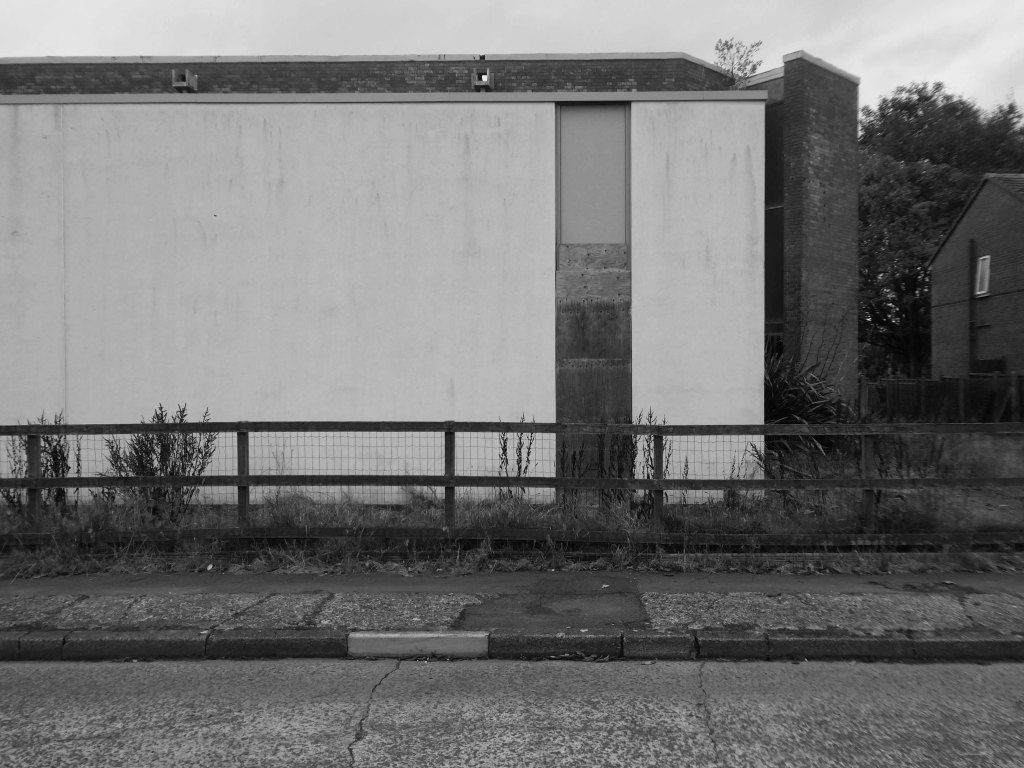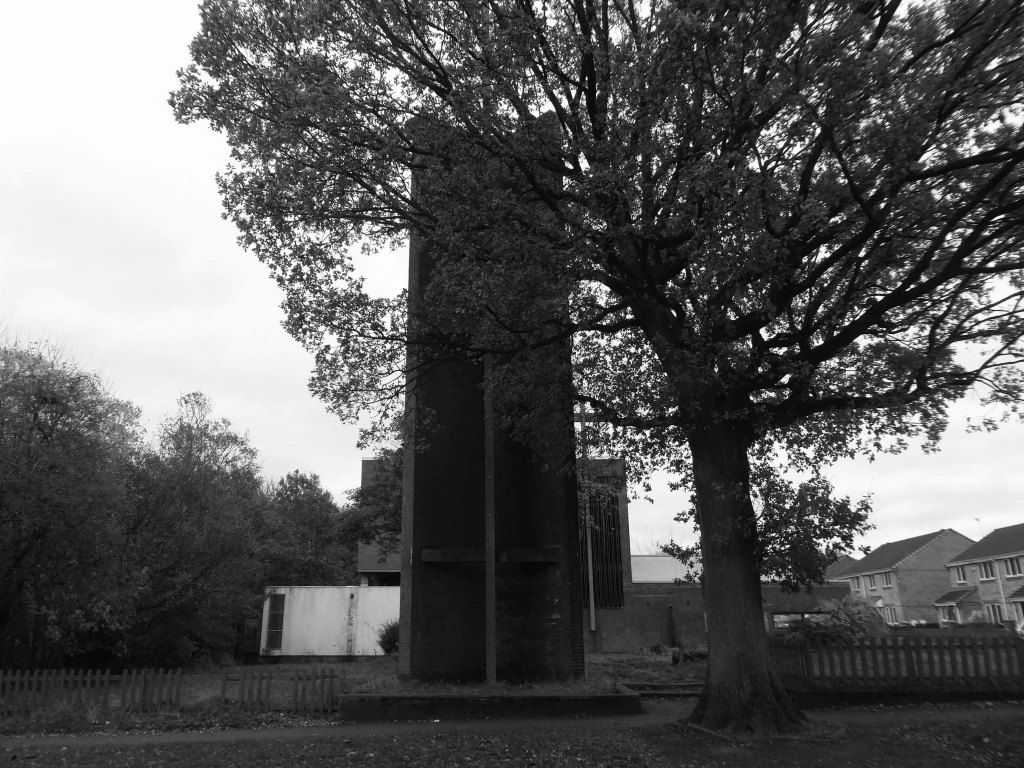66 Chalford Rd Wythenshawe Manchester M23 2SG
Sir Basil Spence 1959-61
In December 1956 Basil Spence and Partners were commissioned to design St Francis Church in Wythenshawe, Greater Manchester. The project was part of a large building programme by the Manchester Diocese and was to service the new post-war housing estate at Newall Green. The site housed an existing hall that had been serving a dual-purpose as church and church hall but which reverted to use as a church hall once the new church was opened. The foundation stone was laid by Colin Skinner CBE on 23 April 1960 and the church was consecrated on 25 March 1961 by the Bishop of Manchester, W D L Greer.
The main building is predominantly brick; it is set back from the road by a landscaped courtyard that includes a brick tower and 73ft concrete cross. Another large cross rises from the front wall of the church itself making it highly visible from the surrounding neighborhood.
The church can hold a congregation of 250. A small chapel is separated from the main church by a sliding screen and can be used independently for private prayer and mid week-services. On busy days the screen can be retracted to provide additional seating to the main church. A gallery over the entrance porch houses two organs and the choir.
Embroidery for the Church was designed by Anthony Blee and carried out by Beryl Dean and Associates, and Communion silver was specially designed by Gerald Benney.









An austerely simple deign, saved from bleakness by a few deft touches – Pevsner.
The lettering on the font cover is by Ralph Beyer, the painting on the east wall by William Chattaway, who came specially from Paris to paint.

2010 – John Richards


The church also contains four stones brought from prominent Christian locations across the globe including a rose hued stone from Assisi itself, these are embedded in the walls and floor around the building.

Construction.


Completion.
St Francis of Assisi’s Church in Wythenshawe stands testimony to the vigour of its first priest, the Reverend Ronald Pitcher. It was Pitcher who organised a local campaign to raise money for its construction, even before William Greer, Lord Bishop of Manchester, launched a wider appeal to fund churches and vicarages in new housing areas throughout the diocese.
It was probably also Pitcher who chose the architect, since he made initial contact with Basil Spence late in 1956. Drawings and a watercolour perspective were prepared by the beginning of 1958, when the scheme was priced at £17,500, exclusive of professional fees.
Following discussions with the congregation it was modified to provide side-aisles, and the estimate increased to £27,000, including an organ. Although the diocese believed the final cost might be as high as £35,000,the design was accepted and Spence formally commissioned at the end of the year.
2012


A church forced to close three years ago after its congregation dwindled to just two has been reborn – as a community centre.
St Francis of Assisi, in Wythenshawe, was forced to shut its doors when its popularity waned and repairs became too expensive.
Now, thanks to businessman James Munnery and Pastor William Simoes, the former Church of England building is rising again as a beacon of hope for the neighbourhood. The pair have teamed up to re-open the church as the New Life Opportunities Centre. Ambitious plans for the not-for-profit venture include sports pitches, a recording studio, and a hall for events and dancing.
It will also hold church services.

























The sound of the pipe organ





I cycled past this recently and keep meaning to go back for a proper look. It’s astonishing, a total deconstruction of what a church can look like.
LikeLike
I have fond memories of st Francis when i was very young, but would love to know if i was babtised there as am cinfused about many online listings Can anybody help? Paula Davies DOB 27 04 1953 i lived at 9, Ninfield Rd, Wythenshawe with my mum n dad Alan Edward Davies and Dorothy Rose Davies ,and my four sisters Suzanne,Jayne,Leigh,Caroline
LikeLike
Brings back memories. My parents were Baptists but we went to the Methodist church on Dobbinets [Sp?] Lane until the little dual-purpose Baptist church was built at Newall Green. Later, I met an Irish RC nurse working at Withington Hospital, became a Catholic, moved to Leeds, then to near Sheffield, and finally to Sudbury in Suffolk, where my wife died earlier this year. In 1985 I obtained a PhD with a survey of developments in RC church architecture in the UK and Ireland, prompted by my earlier engagement with Spence’s design for St Francis – and my minimal contribution of the design of one of the altar-rail kneelers; the one furthest away in the photo on the above website. I’m now 86.
LikeLike
Thanks so much for your very personal contribution.
LikeLike
PS The photo reminds me I also did the designs for the squared-off elliptical needlework panels on the kneelers of the two faldstools (just visible in the photo}. I wonder if these survived the discontinuation of the place’s use for worship. If they did, where might they found? I wouldn’t mind being reunited with the panels, if the kneelers are redundant.
LikeLike
The church was cleared when it was deconsecrated – I assume the contents may have been relocated by the Diocese.
LikeLike